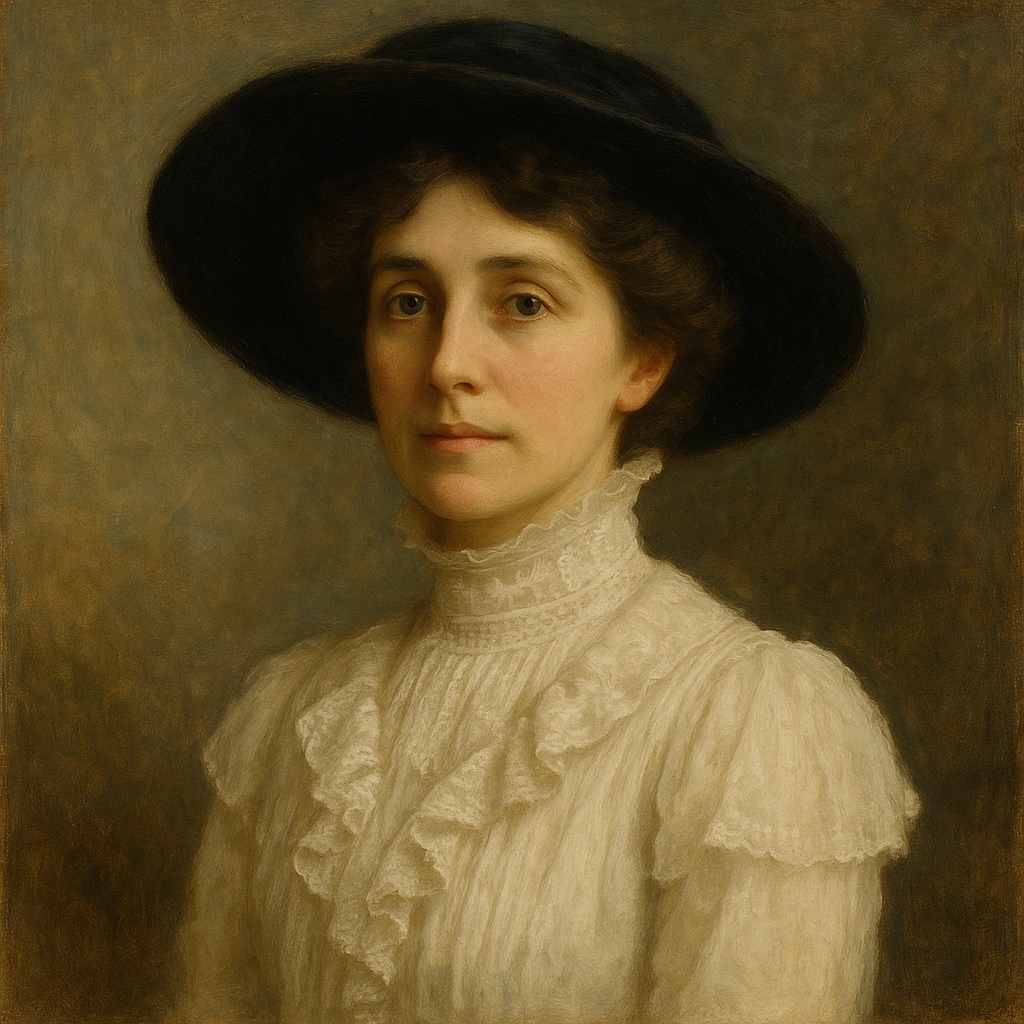1 Poems by Josephine Preston Peabody
1874 - 1922
Josephine Preston Peabody Biography
Josephine Preston Peabody stands as a fascinating figure in American poetry, a poet and playwright whose works embody an era of literary transition from the late Victorian romanticism into the more nuanced and exploratory early modernist phase. Born on May 30, 1874, in New York City, Peabody spent much of her life capturing beauty in a world that was often harsh to her. Her poetic style is marked by an elegant simplicity, a romantic fervor, and a moral intensity reflective of her inner life and social concerns. Yet, despite the attention she received during her lifetime and her unique contributions to both poetry and drama, Peabody has largely faded from literary memory, overshadowed by more experimental voices that emerged in the early 20th century. Exploring her life, artistic inspirations, and literary legacy offers insight into a deeply sensitive artist who engaged both heart and mind with the social and artistic issues of her time.
Peabody’s childhood was marked by early loss and financial hardship. Her father, a medical doctor, died when she was only seven years old, leaving her family in a precarious financial situation. This led her mother to move the family to Dorchester, Massachusetts, where Josephine and her siblings faced a new life filled with economic instability. Despite these difficulties, she was a precocious child, voraciously consuming literature from a young age and developing a lifelong love for the works of Shakespeare, Romantic poetry, and the emerging voices of American literature. Her early exposure to these influences would shape her artistic style, providing a foundation of romantic sensibility that she would bring to bear in her later, more socially attuned works. This literary immersion, coupled with her acute sensitivity to her own and others' suffering, fostered in her a profound empathy, one that resonated in her poetry as she sought to evoke beauty while also grappling with social issues and human suffering.
Peabody’s education continued to be shaped by both public schooling and her own autodidactic pursuits. At the age of 14, she began writing poetry in earnest, submitting her work to local publications and gaining a modicum of recognition. She attended the Girls' Latin School in Boston, where she received a classical education that further developed her intellectual and literary interests. Following high school, Peabody entered Radcliffe College, then the women’s counterpart to Harvard, though her studies were intermittent due to financial pressures. At Radcliffe, she encountered the intellectually stimulating environment she had longed for, studying under figures like George Santayana, whose philosophical teachings left an indelible impression on her understanding of beauty, morality, and art. Though she never completed her degree, her time at Radcliffe exposed her to the rigorous academic milieu that would deepen her sense of literary purpose and shape her ethical considerations as an artist.
Peabody’s literary career began to take shape in her early twenties, as she started publishing her poetry in well-known periodicals of the day, including The Atlantic Monthly, Scribner's Magazine, and Harper's Monthly. Her work quickly garnered attention for its musicality and emotional depth, and she was recognized as a promising young poet. Her early collections, such as Old Greek Folk Stories Told Anew (1897) and The Singing Leaves (1903), reflect her fascination with mythology, fairy tales, and classical themes, echoing her lifelong admiration for Keats and Tennyson. These early works reveal a desire to bridge the fantastical with the moral, the personal with the universal, a tendency that would characterize much of her writing. Peabody's poetic voice in these early collections is tender, almost childlike in its wonder at the world’s beauty, yet unmistakably serious in its undertones, often exploring themes of loss, love, and the redemptive power of beauty.
In 1906, Peabody published The Book of the Little Past, a collection of poems inspired by her childhood memories and dedicated to her young daughter. This work stands as one of the finest examples of her poetic exploration of innocence and memory, her lyrical style infusing ordinary moments with a magical resonance. The Book of the Little Past is an exemplar of her belief in the moral imagination, the idea that art could be both beautiful and edifying, awakening the reader to a greater sensitivity to life’s mysteries and injustices. Through these poems, Peabody evokes a deep sense of nostalgia, employing simple language to capture the inner landscapes of childhood. At the same time, these verses subtly reflect her more mature reflections on the passage of time, the inevitability of change, and the fleeting nature of innocence, themes that would recur throughout her work.
Despite the ethereal quality of much of her early poetry, Peabody was deeply engaged with the social issues of her time, particularly regarding the rights of women and the plight of the working class. Her commitment to these causes is evident in her play The Piper (1909), which won the Stratford-upon-Avon Prize in England and became one of her most celebrated works. The play is a reimagining of the Pied Piper legend, but with a focus on the social and moral questions raised by the tale. Set in a town beset by both plague and poverty, The Piper explores themes of social justice, the responsibility of leadership, and the tension between individual desires and communal obligations. In The Piper, Peabody employs the figure of the Pied Piper not merely as a fantastical character but as a symbolic force questioning authority and addressing the social failings of the community. The play’s success on both sides of the Atlantic affirmed Peabody’s reputation as a serious dramatist and social commentator, showcasing her ability to fuse her lyrical sensibilities with a poignant critique of societal injustices.
In addition to The Piper, Peabody’s plays often reflected her progressive views on gender and the role of women in society. She was a vocal advocate for women’s rights, aligning herself with the suffragist movement and expressing her belief in women’s intellectual and creative potential. Her work in theater, an area still largely dominated by men at the time, was itself a testament to her feminist ideals. She frequently depicted female characters who challenged traditional gender roles and sought agency within their societal confines, reflecting her conviction that women had a vital role to play in shaping the world’s moral and artistic landscape. Her play Fortune and Men’s Eyes (1900) and her later drama Marlowe (1922), both contain female characters who defy conventional expectations, seeking to assert themselves as moral and intellectual agents in a male-dominated society.
Peabody’s later poetry continued to grapple with these themes, albeit in a more introspective and philosophical vein. In The Singing Man (1911), one of her most acclaimed collections, Peabody confronts the ethical responsibilities of the artist, the impermanence of beauty, and the enduring power of the human spirit. These poems often reflect a more somber, reflective tone than her earlier work, revealing her grappling with personal loss, the ravages of time, and the disillusionments of adulthood. Yet, even in these more melancholic pieces, Peabody’s faith in the transcendent qualities of art and the resilience of the human spirit shines through, underscoring her belief in beauty as a form of redemption and moral illumination. The poems in The Singing Man exemplify her mature style, combining her lyrical gifts with a philosophical depth that speaks to the complexities of the human condition.
Throughout her career, Peabody’s work was informed by her dedication to both beauty and justice, a commitment that has occasionally made her difficult to categorize within the conventional narratives of American literary history. Unlike the more experimental poets of her time, such as T.S. Eliot or Ezra Pound, Peabody remained largely committed to traditional forms and a lyricism that, while increasingly out of vogue in the early 20th century, allowed her to engage deeply with her moral convictions. Her stylistic conservatism may have contributed to her gradual marginalization within the canon, but it also gives her work a distinctive voice that resonates with an earnestness and ethical clarity often absent in the more ironic or fragmented poetry of her modernist contemporaries.
Peabody’s later years were marked by personal challenges, including struggles with health and the death of her husband, Lionel Marks, in 1939. Yet, even as she faced these difficulties, she continued to write, finding solace and purpose in her art. In the years following her husband’s death, her work took on an even more meditative tone, as she reflected on themes of mortality, legacy, and the transcendent qualities of love and beauty. Though she published less frequently in her later years, she remained a revered figure among those who appreciated her unwavering dedication to the ideals of beauty and moral purpose in art.
Josephine Preston Peabody died on December 4, 1922, leaving behind a body of work that reflects the complexities of her artistic and ethical vision. Though she may not have achieved the lasting fame of her more experimental peers, her poetry and plays provide a compelling portrait of an artist deeply engaged with both the beauty and suffering of the world around her. Her legacy endures in the quiet resilience of her verse, in her commitment to social justice, and in her faith in the power of art to inspire empathy and moral reflection. Peabody’s work invites readers to remember that the pursuit of beauty need not be an escape from the world’s problems, but rather a way of engaging with them, offering hope, solace, and a vision of a more compassionate society. Her life and work remain a testament to the enduring relevance of art that speaks to both the heart and the conscience, an art that, in her own words, "sings man back to man."
This text was generated by AI and is for reference only. Learn more
Username Information
No username is open
Everything is free to use, but donations are always appreciated.
Quick Links
© 2024-2025 R.I.Chalmers (V2Melody).

All music on this site by R.I.Chalmers (V2Melody) is licensed under a Creative Commons Attribution-NonCommercial 4.0 International License.
Attribution Requirement:
When using this music, you must give appropriate credit by including the following statement (or equivalent) wherever the music is used or credited:
"Music by R.I.Chalmers (V2Melody) – https://v2melody.com"
Support My Work:
If you enjoy this music and would like to support future creations, your thanks are always welcome but never required.
Thanks!


